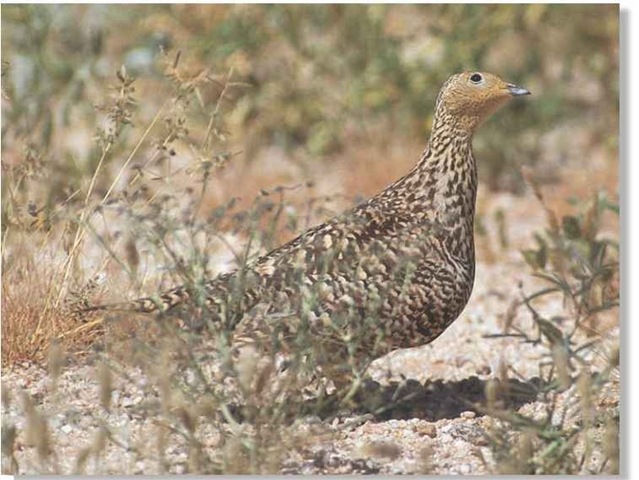ORDER
Pterocliformes
FAMILY
Pteroclidae
GENUS & SPECIES
key features
• When faced with danger, this bird escapes by jumping from the ground directly into flight j • Male soaks water into his belly feathers, which he then takes to the nest for his young to drink I • Male incubates the eggs at night, while the female remains at the nest during the day
where in the world!
Found in southern Africa from Angola and Nambia to Zimbabwe and Botswana; also in the Kalahari Desert and South Cape Province
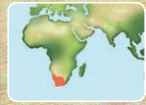
Lifecycle
The sandgrouse’s activities revolve around getting water; like clockwork, flocks visit water holes to drink, and males soak their belly feathers for transport to their chicks.
Habitat
The Namaqua sandgrouse inhabits the deserts and desert fringes of southern Africa. It prefers flat or rolling country with short, thin grass and dry, sandy soil that is covered with scattered shrubs and succulent plants.The bird also lives in more heavily wooded dry savannahs. In the Kalahari desert, the bird occurs on sandy savannahs with denser vegetation but is most common in areas that receive little rainfall.The sandgrouse will fly miles over desert terrain in search of water If a watering hole dries up, it will journey with large flocks until another hole is found.
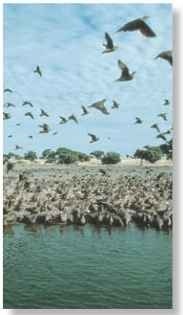
A Wide but wet sandgrouse favor open areas with water holes nearby.
Food & feeding
Seeds are the main staple of the Namaqua sandgrouse, which forages over large areas — not the typical small range of most birds in the sandgrouse family.The bird prefers seeds high in protein, like legumes, picking them off the ground with its short bill. It feeds in the daylight hours and rests in the shade of a bush during the extreme heat of the midday.The bird will sometimes eat plant material and insects or mollusks that happen to be on plants, and occasionally grit to help grind down seeds in the gizzard.The Namaqua sandgrouse needs to drink water every day and may fly up to 50 miles to find a watering hole.The bird is joined by other large flocks, which all arrive at the same time: usually between 8 to 10 a.m. but sometimes in late afternoon.The birds may land as far as 5 miles from a water hole, rest from their long flight, and then walk the rest of the way The sandgrouse will quickly take about 10 gulps, raising its head to swallow between each one.
Breeding
Namaqua sandgrouse breed all year; but most mating occurs from July to November, when rainfall is more plentiful. During courtship, the male sandgrouse struts after the female with his tail raised and fanned and his head drawn to his shoulder. The female sometimes reciprocates with her own similar ground display Monogamous pairs form strong pair bonds; mates stay together in small parties and sometimes in large breeding flocks. The nest is a simple scrape in bare soil or among stones, grass tufts or scrub, and the birds’ nests are usually more than 60′ apart.
A clutch usually consists of three eggs, though it may have two to nine; the eggs are never left unattended during the 21-day incubation period. The male incubates mainly at night from 14-18 hours, while the female’s daytime duty rarely exceeds 10 hours. When the bird is relieved during incubation, it throws small stones to one side with its bill; the reason is unknown. Once the yellowish-brown chicks hatch, one parent always carries the eggshells away from the nest to avoid attracting predators, such as foxes and jackals. Chicks feed on seeds within hours of hatching, with their mother close by Young sandgrouse are half their adult size and fully feathered at 3 weeks, and are flying at 6 weeks. The male provides chicks with water from birth until at least two months after they start to fly, since chicks usually still cannot get to the watering hole. He soaks up water in his belly feathers and returns to give it to the chicks, standing erect as they drink from a central groove in his plumage.
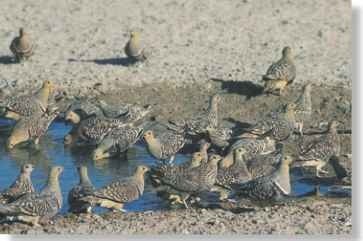
A Where sandgrouse gather
Flocks visit a water hole every morning. some travel great distances and spend only 15 seconds getting a drink.

always involved
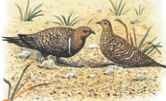
Excavator…
A Namaqua sandgrouse male helps his mate form a shallow nest hollow in the very dry ground of the African desert.
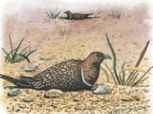
Incubator…
The sandgrouse male relieves his mate each evening at dusk and takes his turn incubating their eggs for up to 18 hours.

Defender…
After the chicks have hatched, the male carries the egg shells away from the nest to prevent predators from locating the chicks.
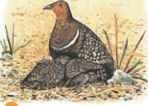
Dispenser
The male brings water back to the nest in his wet belly feathers. The young appear to nurse as they eagerly clamor for a refreshing drink.
Conservation
Though not globally threatened, certain populations of Namaqua sandgrouse, including the Orange Free State birds, have disappeared because of severe drought and habitat destruction. But the future appears bright for the bird, due to decreased hunting and the availability of watering holes created by agricultural projects.
Behavior
Namaqua sandgrouse are not very territorial birds, nor are they demonstrative in courtship displays. But they are very protective of their young, taking great pains to keep predators at bay. If threatened, the bird will lower its head and run at its enemy. Sandgrouse vocalizations include a mellow whistle and a chuckle, usually heard during flight. Because they are a favorite target of birds of prey, which frequent watering holes, Namaqua sandgrouse crouch in the ground to avoid detection, and can lift off quickly. In high temperatures, the bird tends to become inactive, seeking shade and drooping its wings, holding them away slightly from the body to increase heat loss.
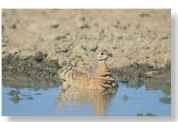
A sandgrouse sponge
A male transports water to his young in his feathers.
The crop of a chick a few days old contained 1,400 tiny seeds — some as small as grains of sand.
# The male Namaqua sandgrouse can carry 1.5-2 oz. of water in its belly feathers. After a journey of 120 miles in half an hour, they can give their chicks 0.75-1 oz. Water loss is due mainly to evaporation.
PROFILE
Namaqua Sandgrouse
Dry desert conditions are no threat to the Namaqua sandgrouse: its thick-soled feet can withstand hot sand, and its belly feathers carry water.
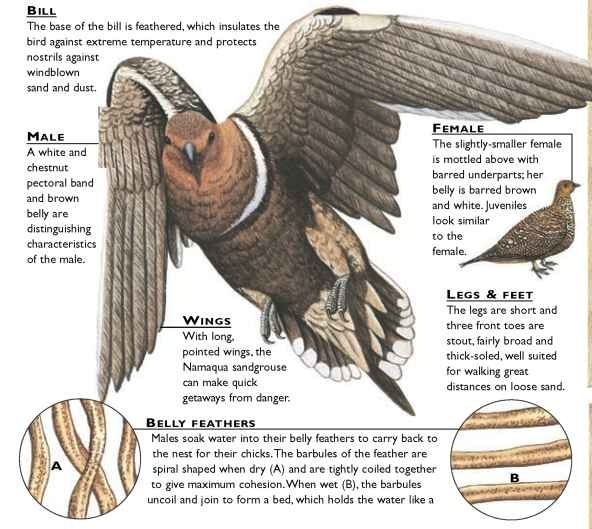
Creature comparisons
Measuring up to 16″ in length and weighing up to 11 oz., the Pallas’s sandgrouse (Syrrhaptes paradoxus) is larger than the Namaqua sandgrouse. Both females (shown) have mottled plumage. Unlike its relative, the Pallas’s sandgrouse has no hindtoe, and its legs and feet are completely feathered, an adaptation for the cooler temperatures in its habitat.The bird lives in steppe and semidesert areas, from Kazakhstan through China, Asia, Siberia and Mongolia, far from the Namaqua sandgrouse. But the birds have very similar behavionthey both eat seeds and visit watering holes daily, and males of both species provide water to the chicks through their water-laden belly feathers.
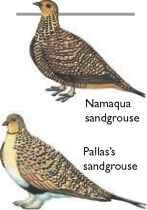
| VITAL STATISTICS . Weight 5-7 oz.,. |
|
| Length | 11″ |
| Sexual ^Maturity | 1 year |
| Breeding Season |
Year-round; mainly after rains and in cooler months |
| Number of Eggs | 2-9, usually 3 |
| Incubation ‘ Period | 21 days |
| Fledging . Period | 28 days |
| Breeding Interval | 1 year |
| Typical Diet | Mainly seeds |
| Lifespan | Unknown |
RELATED SPECIES
• The Namaqua sandgrouse is 1 of 14 species of sandgrouse in the genus Pterocles, including the spotted sandgrouse, P. senegallus, and Madagascar sandgrouse, P. personatus. All have three front toes and a small, raised hindtoe. Two other species of sandgrouse in the genus Syrrhaptes (Greek for “sewn together”) have only forward-facing toes that are fused together.
